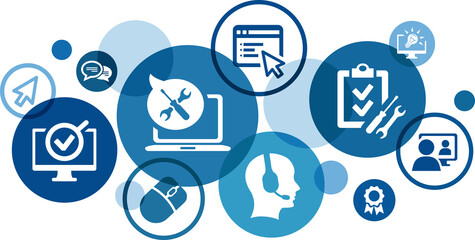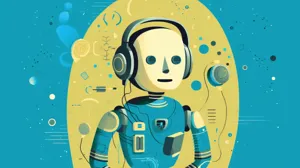If you’ve recently visited a company's website, there's a good chance you've encountered a customer service chatbot. Maybe you were trying to get an answer to a question, check your order status, or just poking around out of curiosity. Whatever the reason, AI chatbots are becoming a big part of our online experience.
Our digital world is moving fast, and companies are changing the way they interact with us. AI-powered chatbots are at the forefront of this change, making sure we get quick responses and personalised help anytime we need it. As businesses embrace these new solutions, customer service is being redefined, delivering faster and more tailored solutions that meet the unique needs of each individual.
In this blog post, we will examine how these chatbots are transforming customer service and what makes them so beneficial for both businesses and customers.
What is an AI customer service chatbot?
In simple terms, an AI customer service chatbot is a smart software that can chat with you like a human would, whether through text or voice. These chatbots use artificial intelligence (AI) - specifically natural language processing (NLP) and machine learning (ML) - to understand what you’re saying and respond appropriately in real time.
If those terms sound a bit technical, don’t worry! Here’s a quick rundown:
- Natural Language Processing (NLP): This refers to the branch of artificial intelligence that focuses on enabling machines to understand, interpret, and generate human language in a way that is both meaningful and useful. NLP involves tasks such as language translation, sentiment analysis, and text summarization.
- Machine Learning Technologies (ML): Machine learning involves using algorithms and statistical models to enable computers to learn from and make predictions or decisions based on data. In the context of chatbots, ML helps the system improve its responses over time by analysing patterns and learning from previous interactions.
In simple terms, we can say that an AI customer service chatbot is a technological tool that mimics human interaction to assist customers through text or voice. It uses artificial intelligence to understand and respond to user questions and issues in real time, continually learning and improving through experience.
How do AI customer service bots work?
AI chatbots blend machine learning and NLP to get a good grasp of what you're asking and respond in a natural, fluid way. Initially, they're trained with machine learning algorithms to give accurate answers to a wide range of questions. Over time, they learn from every interaction, getting better and more accurate.
Pretty cool, right? But you might be wondering what kinds of chatbots are out there.
Types of chatbots
It is a common belief that all chatbots use artificial intelligence systems, but this is not entirely accurate. Chatbots can be classified into three main categories, each with distinct characteristics and capabilities. Here is a detailed description of these three categories:
- Rule-based chatbots: Rule-based chatbots, also known as guided response chatbots, follow a set of predefined rules and scripts established by developers that dictate how the chatbot should respond to specific questions or commands from users. The main advantage of this type of chatbot is its ease of implementation and low cost, as it does not require advanced technologies. However, it can only handle straightforward, predictable conversations.
- AI-powered chatbots: Unlike rule-based chatbots, they use NLP and ML to understand the context and meaning behind your questions, offering more accurate and relevant responses. They’re great for handling complex conversations and can improve over time, adapting to new situations and learning from previous interactions.
- Hybrid chatbots: Hybrid chatbots combine the best of both worlds. They use rules and scripts to handle basic and predictable interactions while also employing AI technologies to manage more complex queries and adapt to new situations. This hybrid approach allows chatbots to provide a more seamless and efficient user experience.
Depending on their needs and available resources, companies will choose one type of chatbot over another, enabling them to maximise the benefits and fully leverage the features these tools offer.
Benefits of AI chatbots in customer service
The arrival of generative AI chatbots has fundamentally changed the customer service landscape. Modern AI chatbots don’t just wait for you to ask a question; they can anticipate your needs, making the whole process smoother and more satisfying.
Here are some of the benefits of using AI chatbots in customer service:
- Enhancing response times with AI chatbots: Traditional customer support often involves waiting in long queues, leading to customer frustration and dissatisfaction. However, AI customer service bots can handle multiple queries simultaneously, providing instant responses and reducing wait times.
- Offering personalised assistance 24/7: Unlike human agents who have limited working hours, AI support chatbots are available 24/7, ensuring that customers receive the help they need whenever they need it. These bots can analyse previous interactions and data to provide personalised responses any time of day.
- Cost efficiency: Implementing AI chatbots can lead to significant cost savings for businesses. By automating routine and repetitive tasks, chatbots reduce the need for a large customer support team. This allows human agents to focus on more complex issues that require a personal touch, ultimately lowering operational costs.
- Personalization: AI chatbots can access and analyse a vast amount of customer data to offer tailored interactions. AI chatbots remember past interactions and preferences, offering tailored recommendations and solutions. This level of personalization improves customer satisfaction and loyalty.
- Scalability: AI chatbots are highly scalable, capable of managing increased customer interactions without additional resources. During high-traffic periods or promotional campaigns, chatbots can handle the surge in inquiries seamlessly, ensuring consistent service quality and preventing bottlenecks.
- Data collection: AI customer service chatbots can collect a lot of data from customer interactions, offering valuable insights into what customers need and prefer.
Challenges and Limitations of AI Chatbots in Customer Service
While AI chatbots offer many advantages, they also present certain challenges and limitations. It's important to understand these to use the technology effectively and ensure a positive experience for both businesses and customers.
- Understanding complex language: Despite significant advancements, chatbots can struggle with interpreting questions or requests that deviate from expected patterns or contain slang, idioms, or typos. This can lead to incorrect or frustrating responses for users.
- Need for human oversight: Even though chatbots can handle many interactions autonomously, they still require human oversight and support, especially for complex or sensitive issues. Human agents may need to step in to resolve problems beyond the chatbot's capabilities, ensuring customers receive appropriate assistance and maintaining satisfaction.
- Integration with existing systems: Implementing AI chatbots can be tricky when it comes to integrating with a company's existing systems and databases. For chatbots to work well, they need access to accurate, up-to-date information, which might mean making technical adjustments and investing extra resources.
- Initial costs and maintenance: While chatbots can save money in the long run, the initial development and implementation costs can be high. Plus, ongoing maintenance and updates are necessary to keep improving performance and adapting to new situations.
- Security and privacy concerns: Security and privacy are crucial when using AI chatbots, especially in sectors like banking or healthcare that handle sensitive information. Companies must ensure their chatbots comply with data privacy and security regulations and put measures in place to protect customer information and prevent unauthorised access.
- Language and cultural barriers: To be effective worldwide, chatbots need to manage multiple languages and adapt to different cultural contexts. This requires specialised development and training to understand local nuances and customs. Without proper adaptation, chatbots may fail to deliver satisfactory service.
Recognizing and addressing these challenges and limitations is essential for getting the most out of AI chatbots in customer service.
Conclusion
The impact of AI chatbots in customer service is huge. These smart bots are redefining traditional support models and transforming how businesses connect with customers. As more companies start using AI-powered chatbots, the benefits will only grow, making customer service faster, more efficient, and more personalised.
Embracing this technology is a must for businesses wanting to stay competitive in the digital age. By leveraging AI chatbot customer support, companies can deliver exceptional service, build stronger customer relationships, and drive long-term success. The future of customer service is here, and it’s powered by AI!






